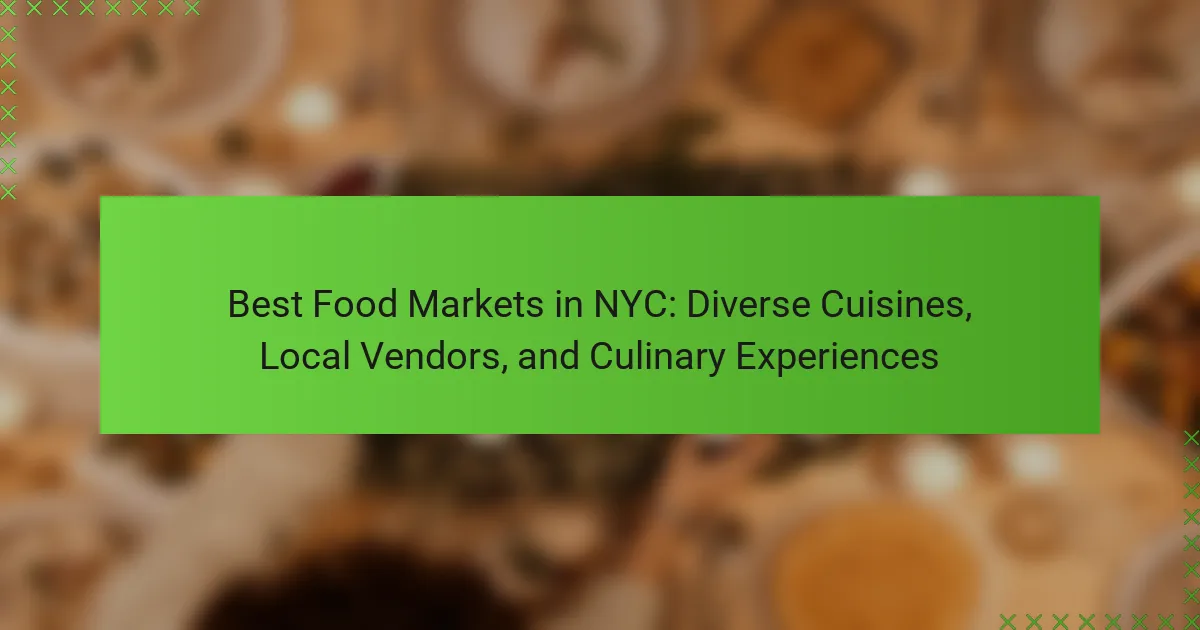
What are the Best Food Markets in NYC?
The best food markets in NYC include Chelsea Market, Smorgasburg, and Eataly. Chelsea Market offers a variety of food vendors and artisanal products. It is located in the Meatpacking District and features over 35 vendors. Smorgasburg is an outdoor food market with over 100 local vendors. It operates on weekends in Brooklyn and showcases diverse cuisines. Eataly is an Italian marketplace with restaurants, cafes, and food counters. It provides a unique shopping and dining experience in the Flatiron District. Each market highlights local vendors and culinary creativity.
How do food markets in NYC reflect diverse cuisines?
Food markets in NYC showcase diverse cuisines through a wide array of international food offerings. Each market features vendors representing different cultural backgrounds. For example, the Queens Night Market highlights foods from over 80 countries. This market includes vendors serving Filipino, Colombian, and Moroccan dishes. Similarly, the Smorgasburg market presents a variety of global cuisines, including Japanese, Indian, and Italian. The presence of these vendors illustrates the city’s multicultural population. Additionally, food markets often host cultural events and festivals, further promoting culinary diversity. This blend of flavors and foods reflects the melting pot that is New York City.
What types of cuisines can be found in NYC food markets?
NYC food markets offer a wide variety of cuisines. Popular options include Italian, Chinese, Mexican, and Indian. Visitors can also find Middle Eastern, Caribbean, and Korean dishes. Each market showcases local vendors and unique culinary experiences. For instance, the Smorgasburg market features diverse food stalls. Food markets reflect the city’s multicultural population. They provide authentic dishes from around the world. This diversity enhances the culinary landscape of New York City.
How do local vendors contribute to the culinary diversity?
Local vendors enhance culinary diversity by offering unique, regional foods and flavors. They introduce traditional recipes that reflect cultural heritage. Each vendor often specializes in a specific cuisine, showcasing its authentic ingredients and preparation methods. This variety enriches the local food scene and provides consumers with diverse dining options. Vendors frequently source ingredients locally, supporting sustainable practices and promoting seasonal dishes. Their presence fosters community engagement and culinary exploration. Events like food festivals often feature these vendors, highlighting their contributions to the local gastronomic landscape. Ultimately, local vendors play a crucial role in preserving and promoting culinary diversity within the community.
Why are local vendors important in NYC food markets?
Local vendors are crucial in NYC food markets for promoting community engagement and supporting local economies. They provide unique, diverse food options that reflect the city’s multicultural landscape. This diversity enhances the culinary experience for consumers. Local vendors often source ingredients from nearby farms, ensuring freshness and sustainability. They contribute to the vibrancy of neighborhoods, attracting both residents and tourists. According to a report by the NYC Department of Small Business Services, local vendors create jobs and stimulate economic growth. Their presence fosters a sense of community, encouraging social interactions among patrons.
What unique products do local vendors offer?
Local vendors offer unique products such as artisanal cheeses, handmade chocolates, and locally sourced honey. These products are often crafted using traditional methods and local ingredients. For instance, artisanal cheeses are made from milk sourced from nearby farms, ensuring freshness. Handmade chocolates often feature unique flavor combinations inspired by local culture. Additionally, locally sourced honey is produced by bees that pollinate regional flora, enhancing its distinct taste. These offerings contribute to the diverse culinary experiences found in NYC’s food markets.
How does supporting local vendors benefit the community?
Supporting local vendors strengthens the community economically and socially. Local vendors keep money within the community, contributing to local job creation. They often source ingredients from nearby farms, reducing transportation costs and environmental impact. This practice fosters a sense of community and encourages local entrepreneurship. According to the American Independent Business Alliance, local businesses recirculate a greater share of every dollar as they create locally owned supply chains. Supporting local vendors also enhances community identity and pride, as unique local flavors and products are showcased. Additionally, local vendors often engage in community events and support local charities, further enriching community ties.
What culinary experiences can one expect at NYC food markets?
NYC food markets offer a variety of culinary experiences. Visitors can explore diverse cuisines from around the world. Popular markets feature local vendors selling fresh produce, artisanal goods, and specialty items. Street food options are abundant, providing quick bites and unique flavors. Many markets host food festivals and events showcasing local chefs. Cooking demonstrations and tastings are often available to enhance the experience. Seasonal offerings highlight local ingredients and cultural traditions. Overall, NYC food markets create a vibrant atmosphere for food enthusiasts.
What activities and events are commonly held at food markets?
Food markets commonly host a variety of activities and events. These include cooking demonstrations by local chefs. Live music performances often create a vibrant atmosphere. Seasonal festivals celebrate specific cuisines or ingredients. Workshops on food preservation and cooking techniques are frequently offered. Tastings allow visitors to sample different products. Farmers’ markets may feature community gatherings and family-friendly activities. Additionally, themed events highlight cultural celebrations related to food. These activities enhance the overall experience for attendees.
How can visitors enhance their culinary experience at these markets?
Visitors can enhance their culinary experience at food markets by sampling diverse offerings. Engaging with local vendors provides insight into the ingredients and preparation methods. Attending cooking demonstrations can introduce new techniques and flavors. Participating in tastings allows visitors to discover unique dishes. Exploring various cuisines expands culinary horizons. Asking vendors for recommendations can lead to hidden gems. Visiting during special events often features exclusive dishes or promotions. Finally, taking notes on favorite items can help in future visits.

How do NYC food markets compare to other cities?
NYC food markets are known for their diversity and vibrancy. They offer a wide range of international cuisines and local products. Markets like Smorgasburg and Chelsea Market showcase unique culinary experiences. In comparison, food markets in cities like Los Angeles focus more on health-oriented options. Chicago’s markets tend to emphasize local produce and artisanal goods. NYC markets also attract a larger number of tourists, enhancing their cultural significance. The city’s food markets often feature a blend of gourmet and street food vendors. This variety sets NYC apart from many other urban food scenes.
What makes NYC food markets unique?
NYC food markets are unique due to their diverse culinary offerings and vibrant atmosphere. They feature a wide range of cuisines from around the world. Local vendors showcase artisanal products and fresh ingredients. Many markets also emphasize sustainability and support for local farmers. The cultural melting pot of NYC reflects in the flavors and dishes available. Events and live entertainment enhance the shopping experience. Markets like Smorgasburg and Chelsea Market attract both locals and tourists alike. These elements combine to create a dynamic food culture that is distinct to New York City.
How do the locations of these markets influence their offerings?
The locations of food markets in NYC significantly influence their offerings. Markets situated in diverse neighborhoods reflect the cultural backgrounds of their communities. For example, markets in areas with large Hispanic populations often feature authentic Latin ingredients and dishes. Similarly, markets in Chinatown offer a wide variety of Asian produce and specialty items. Proximity to local farms affects the availability of fresh, seasonal produce. Urban markets may prioritize convenience foods due to busy lifestyles. Additionally, tourist-heavy areas often showcase gourmet and artisanal products to attract visitors. Therefore, the geographic and demographic context shapes the types of foods and products available in each market.
What role does culture play in shaping NYC food markets?
Culture significantly influences the food markets in NYC. It shapes the variety of cuisines available. Diverse immigrant communities contribute unique culinary traditions. These traditions blend with local ingredients and cooking styles. Markets reflect the city’s multicultural identity. For example, neighborhoods like Chinatown and Little Italy showcase specific cultural foods. Festivals and cultural events further promote these cuisines. This dynamic fosters a vibrant food scene that attracts residents and tourists alike.
What are the challenges faced by food markets in NYC?
Food markets in NYC face several challenges. High rent costs significantly impact operational expenses. Limited space restricts vendor opportunities and product variety. Regulatory compliance adds complexity to market operations. Competition from supermarkets and online grocery services is intense. Seasonal fluctuations affect customer traffic and sales. Supply chain disruptions can lead to product shortages. Labor shortages hinder staffing and service quality. These challenges necessitate innovative solutions for market sustainability.
How do regulations affect local vendors?
Regulations significantly impact local vendors by dictating their operational frameworks. These rules encompass health, safety, and zoning laws. Compliance with health regulations ensures food safety for consumers. Local vendors must obtain permits, which can be costly and time-consuming. Zoning laws restrict where vendors can operate. This limits their market access and potential customer base. Additionally, regulations may impose taxes or fees that affect profit margins. Studies show that stringent regulations can lead to decreased vendor participation in markets. Overall, regulations shape the viability and success of local vendors in food markets.
What economic factors influence the sustainability of food markets?
Economic factors influencing the sustainability of food markets include supply and demand dynamics, pricing strategies, and consumer behavior. Supply and demand directly affect market stability. When demand for local produce rises, sustainability improves. Pricing strategies also play a crucial role; fair pricing ensures that local vendors can thrive. Consumer behavior, such as the preference for organic or locally sourced products, drives market trends. Additionally, economic policies and subsidies can impact the viability of sustainable practices. For instance, government incentives for sustainable farming can enhance food market sustainability. These factors collectively determine how food markets adapt to economic changes while promoting sustainability.

Where can I find the best food markets in NYC?
The best food markets in NYC can be found in various neighborhoods. Notable locations include the Chelsea Market, which features a mix of local vendors and diverse cuisines. Another popular spot is the Smorgasburg, held in Williamsburg and Prospect Park, showcasing a variety of food stalls. The Union Square Greenmarket offers fresh produce and artisanal goods from local farmers. Additionally, the Essex Street Market on the Lower East Side provides a selection of international foods and local delicacies. Each of these markets is known for its unique offerings and vibrant atmosphere, making them top destinations for food enthusiasts.
What are the top-rated food markets in NYC?
The top-rated food markets in NYC include Chelsea Market, Smorgasburg, and Eataly. Chelsea Market features a variety of local vendors offering artisanal foods. It is known for its vibrant atmosphere and diverse culinary options. Smorgasburg is an outdoor food market that showcases a wide range of food vendors. It attracts thousands of visitors every weekend during the warmer months. Eataly provides an Italian marketplace experience with restaurants, cafes, and a grocery store. Each market offers unique dining experiences and a taste of local culture. These food markets are highly rated for their quality and variety.
What features make these markets stand out?
The features that make these markets stand out include diverse cuisines, local vendors, and unique culinary experiences. Each market offers a variety of food options reflecting different cultures. Local vendors provide fresh, often organic produce and artisanal products. The markets frequently host events and cooking demonstrations, enhancing the visitor experience. Many markets emphasize sustainability and support local agriculture. Unique atmospheres create vibrant social spaces for community interaction. Seasonal offerings highlight local ingredients and specialties. These characteristics contribute to the markets’ popularity and distinctiveness in NYC.
How do customer reviews influence market popularity?
Customer reviews significantly influence market popularity by shaping consumer perceptions and decisions. Positive reviews enhance credibility and attract new customers. A study from the Harvard Business School found that a one-star increase in Yelp ratings can lead to a 5-9% increase in revenue. Conversely, negative reviews can deter potential customers and harm sales. Many consumers trust online reviews as much as personal recommendations. This trust translates into increased foot traffic and sales for markets with favorable reviews. Therefore, customer reviews are crucial for determining a market’s success and popularity.
What tips should I consider when visiting NYC food markets?
Visit NYC food markets during off-peak hours for a more enjoyable experience. Early mornings or weekdays usually have fewer crowds. Plan your route to include diverse vendors for a variety of cuisines. Research market schedules, as some are only open on specific days. Bring cash, as some vendors may not accept cards. Stay hydrated and wear comfortable shoes, as you may walk a lot. Sample small portions to try more foods without overeating. Engage with vendors to learn about their products and cooking methods. Lastly, check for any special events or live entertainment happening during your visit.
How can I navigate large markets effectively?
To navigate large markets effectively, develop a clear strategy before your visit. Research the market layout and vendor offerings in advance. Familiarize yourself with the types of cuisines available. This will help you prioritize which vendors to visit. Create a list of must-try dishes or products. This focused approach minimizes decision fatigue. Arrive early to avoid crowds and enjoy a more relaxed experience. Use a map or app to track your location within the market. Engaging with vendors can provide insights and recommendations. This interaction enhances your overall experience and helps discover hidden gems.
What should I keep in mind regarding food safety and hygiene?
Ensure proper food safety and hygiene to prevent foodborne illnesses. Always wash hands with soap before handling food. Clean surfaces and utensils regularly to eliminate bacteria. Store food at safe temperatures to inhibit growth of pathogens. Cook food to the recommended internal temperatures to kill harmful organisms. Avoid cross-contamination by using separate cutting boards for raw and cooked foods. Monitor expiration dates and discard expired items. Following these practices reduces the risk of foodborne diseases, which affect millions annually, according to the CDC.
The main entity of the article is the best food markets in NYC, which include notable locations such as Chelsea Market, Smorgasburg, and Eataly. The article provides an overview of how these markets reflect the city’s diverse culinary landscape, showcasing a variety of international cuisines and local vendors that contribute to the unique food culture. It discusses the importance of local vendors in promoting community engagement and sustainability, as well as the types of culinary experiences available at these markets. Additionally, the article highlights the challenges faced by food markets and offers tips for visitors to enhance their market experience.
